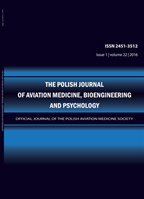2016, Volume 22, Issue 3
Modelling Motion Sickness
Rafał LEWKOWICZ1
-------------------------------------------------------------------------------------------------
1Department of Simulator Studies and Aeromedical Training, Military Institute of Aviation Medicine
Autor korenspondencyjny: Rafał LEWKOWICZ; Department of Simulator Studies and Aeromedical Training, Military Institute of Aviation Medicine; email: rlewkowicz[at]wiml.waw.pl
Full text
Streszczenie
Introduction: Motion sickness is an undesirable phenomenon and continues to be an unresolved problem. Therefore, research is conducted aiming to understand the etiology of this disease better, as well as to anticipate its symptoms. This research is increasingly supported by numerical calculations, for the needs of which models of severity of motion sickness symptoms are developed. The aim this paper is to review and characterize the models of severity of motion sickness symptoms available in the literature, as well as examples of the use of these models in research.
Methods: Systematic review.
Results: The first part describes the four most commonly used models of severity of motion sickness symptoms. A graphic representation of models and mathematical relationships were presented, based on which severity of the disease is determined. Finally, several examples of the use of these models in research are listed.
Conclusions: Taking into account the limitations of using certain models, the most prospective model for predicting severity of motion sickness symptoms was presented. The specific advantages of this model were described, as well as the conditions under which the study using this model should be conducted, in order to ensure reliable results.
Słowa kluczowe
Motion sickness, mathematical model, sensory conflict, subjective vertical.
